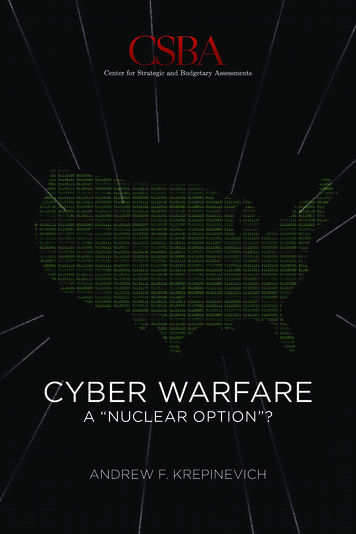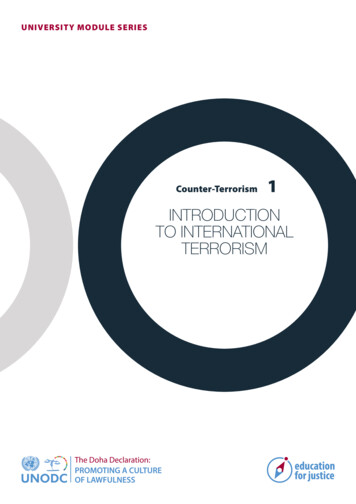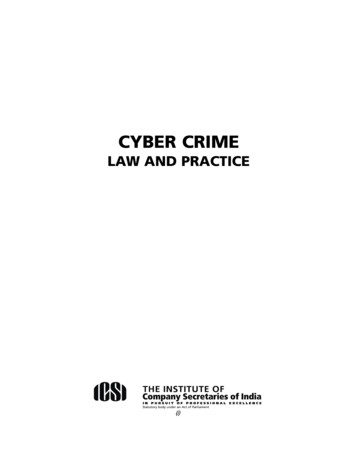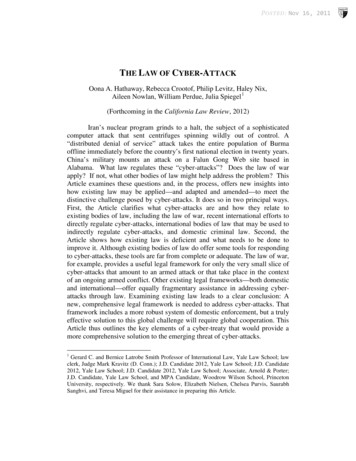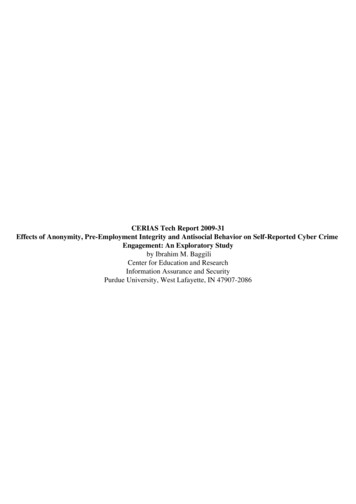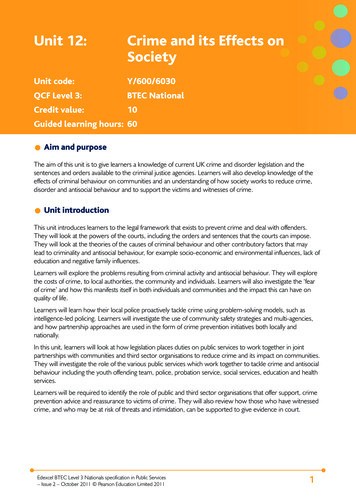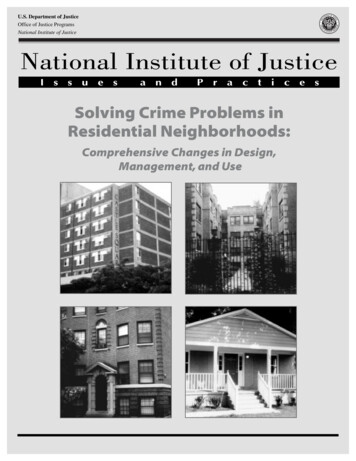
Transcription
Fo u r t h E d i t i o nCyber Crime and CyberTerrorismRobert W. TaylorUniversity of Texas at DallasEric J. FritschUniversity of North TexasJohn LiederbachBowling Green State UniversityMichael R. SaylorUniversity of Texas at DallasWilliam L. TafoyaUniversity of New Haven330 Hudson Street, NY NY 10013A01 TAYL6514 04 SE FM.indd 111/28/17 8:32 PM
Vice President, Portfolio Management: AndrewGilfillanPortfolio Manager: Gary BauerEditorial Assistant: Lynda CramerField Marketing Manager: Bob NisbetProduct Marketing Manager: Heather TaylorDirector, Digital Studio and Content Production:Brian HylandManaging Producer: Jennifer SargunarContent Producer: Rinki KaurManager, Rights Management: Johanna BurkeOperations Specialist: Deidra SmithCreative Digital Lead: Mary SienerManaging Producer, Digital Studio: Autumn BensonContent Producer, Digital Studio: Maura BarclayCover Designer: Studio MontageCover Images: Scanrail1/ShutterstockFull Service Project Management: Ranjith RajaramComposition: Integra Software Services, Ltd.Text Printer/Bindery: LSC Communications, Inc.Cover Printer: Phoenix Color/HagerstownText Font: TimesLTPro-RomanCopyright 2019, 2014, 2013, by Pearson Education, Inc. or its affiliates. All Rights Reserved. Manufactured inthe United States of America. This publication is protected by copyright, and permission should be obtained from thepublisher prior to any prohibited reproduction, storage in a retrieval system, or transmission in any form or by anymeans, electronic, mechanical, photocopying, recording, or otherwise. For information regarding permissions, requestforms, and the appropriate contacts within the Pearson Education Global Rights and Permissions department, pleasevisit www.pearsoned.com/permissions/.Acknowledgments of third-party content appear on the appropriate page within the text.PEARSON and ALWAYS LEARNING are exclusive trademarks owned by Pearson Education, Inc. or its affiliates inthe U.S. and/or other countries.Unless otherwise indicated herein, any third-party trademarks, logos, or icons that may appear in this work are theproperty of their respective owners, and any references to third-party trademarks, logos, icons, or other trade dress arefor demonstrative or descriptive purposes only. Such references are not intended to imply any sponsorship,endorsement, authorization, or promotion of Pearson’s products by the owners of such marks, or any relationshipbetween the owner and Pearson Education, Inc., authors, licensees, or distributors.Library of Congress Cataloging-in-Publication Data 20130477591 17ISBN-13: 978-0-13-484651-4ISBN-10: 0-13-484651-6A01 TAYL6514 04 SE FM.indd 211/28/17 8:32 PM
For my beautiful grandchildren: Madison, Olivia, and Brody; Kylie;August, Axel, and AeroRWTFor Cheryl D. and my J-Kids (Jerod, Jacob, Joley, Jadyn, and Jaxon)EJFFor Allyson and BenJLFor the love of my Life, and my wonderful kids Shelbe, Kyla, Ayden, andKnox for all their love and supportMRSFor the CyberCops and White Hat Hackers who have dedicatedthemselves to making cyberspace a safer place for the restof us and the women in my life who make ours a better world:Renee, Wendi, Samantha, and AshleyWLTA01 TAYL6514 04 SE FM.indd 311/28/17 8:32 PM
A01 TAYL6514 04 SE FM.indd 411/28/17 8:32 PM
CONTENTSPrefacexvAcknowledgmentsSection IxxiiThe Etiology of Cyber Crime and Cyber TerrorismChapter 1 INTRODUCTION AND OVERVIEW OF CYBERCRIME AND CYBER TERRORISM 1Chapter Objectives 1Introduction 1New Threats to the Information Age 2Purpose and Scope of This Book 3Defining the Terms 4Overview 5A Developmental Perspective on a Growing Problem 5The Reality of Increased Cybervictimization 7Changes to Cybervictimization and the Emergenceof Cyber Terror 8The Costs of Cybercrime 9Classification of Computer Crime 12Carter’s Classification of Computer Crimes 13Other Classification Schemes 17Summary 18 Review Questions 19Thinking Exercises 19 Endnotes 19 CriticalChapter 2 CYBER TERRORISM AND INFORMATION WARFARE 22Chapter Objectives 22Introduction 22Defining the Concepts 24Buzzwords: Information Warfare, Cyberterrorism,and Cybercrime 24Risk and Critical Infrastructure Attacks 27Low-Level Cyberwar 27Infrastructure Reliance 28Information Attacks 31Web Site Defacement 32Cyberplagues: Viruses and Worms 32vA01 TAYL6514 04 SE FM.indd 511/28/17 8:32 PM
viContentsDistributed Denial-of-Service Attacks 33Unauthorized Intrusions 35Cyber and Technological Facilitation 36Facilitation of Attack and Disseminationof Ideology 36Data Hiding 37Cryptography 37Propaganda and Promotion 38Funding and Financing TerroristGroups 39Cyberterrorism as an Adjunct Attack 41Al Qaeda, the Islamic State, and Information Technology 41Perspectives on Information Warfare 43The Russian Perspective 43The Chinese Perspective 44Summary 45 Review Questions 46 Thinking Exercises 46 Endnotes 46CriticalChapter 3 THE CRIMINOLOGY OF COMPUTER CRIME 49Chapter Objectives 49Introduction 49Choice Theory 49Routine Activities 50Deterrence Theory 52Psychological Theories 53Moral Development and Crime 53Personality Disorders 54Pedophiles and Psychological Theory 55Social Structure Theories 56Strain Theory 56White-Collar Crime and Strain Theory 58Social Process Theories 59Learning Theory 60Hackers and Learning Theories 67Virus Writers and Learning Theories 69Social Control Theory 70Terrorism and Political Theory 71Summary 74 Review Questions 74 Thinking Exercises 74 Endnotes 74A01 TAYL6514 04 SE FM.indd 6Critical11/28/17 8:32 PM
ContentsviiChapter 4 HACKERS 77Chapter Objectives 77Introduction: What Is a Hacker? 77Who and What Is a Hacker? 78Today’s Hackers 79Defining Hackers 83Cyber criminals Versus Hackers 83Crackers 86Script Kiddies 86White Hat Versus Black Hat 87Hacktivists 88The Origins and History of Hacking 89Hacking Changes 89The Criminalization of Hacking 90Challenges and Changes in Hacking 92The Hacker Subculture 93Technology 94Knowledge 96Commitment 98Categorization 99Law 102Summary 105 Review Questions 105 Thinking Exercises 105 Endnotes 106CriticalChapter 5 SOPHISTICATED CYBER CRIMINAL ORGANIZATIONS 109Chapter Objectives 109Introduction 109Espionage and the Theft of Intellectual Property 111Insider Fraud 115Sabotage 118Sophisticated Criminal Organizations 120The Impact of Organized Crime 120Use of Social Media by Organized Crime 121African Criminal Enterprises 122Asian Criminal Enterprises 123Operation Avalanche 124Balkan Criminal Enterprises 125Eurasian Criminal Enterprises—Russian Organized Crime 126A01 TAYL6514 04 SE FM.indd 711/28/17 8:32 PM
viiiContentsItalian Organized Crime—La Cosa Nostra(LCN) Mafia 126Middle Eastern Criminal Enterprises 128Mexican and South American Drug Cartels 128The Indiscriminant Underground Marketplace—The DeepWeb or Tor Network 129Summary 135 Review Questions 136 Thinking Exercises 136 Endnotes 136Section IICriticalCyber Crime: Types, Nature, and ExtentChapter 6 WHITE-COLLAR CRIMES 138Chapter Objectives 138Introduction 138Embezzlement 139Corporate Espionage 141Money Laundering 144Identity Theft 148Internet Fraud Schemes 152Summary 156 Review Questions 157 Thinking Exercises 157 Endnotes 157CriticalChapter 7 VIRUSES AND MALICIOUS CODE 159Chapter Objectives 159Introduction 159The Language of Malicious Software(Malware) 163Viruses and Other Malware 164History and Development 166Viruses 167Worms 170Trojan Horses 172Adware and Spyware 177Denial-of-Service Attacks 178Blended Threats 178Extent of Viruses and Malicious CodeAttacks 181Virus Writers and Virus Experts 184Summary 189 Review Questions 190 Thinking Exercises 190 Endnotes 191A01 TAYL6514 04 SE FM.indd 8Critical11/28/17 8:32 PM
ContentsixChapter 8 SEX CRIMES, VICTIMIZATION, AND OBSCENITYON THE WORLD WIDE WEB 194Chapter Objectives 194Introduction 194Nature of Exploitation on the Internet 195Online Victimization of Young People 197Cyberbullying 200Stalking via the World Wide Web 201The Mechanisms of Traditional Stalking and Cyberstalking 202Characteristics of Stalkers and Their Victims 204Legislation Targeting Stalking 206Obscenity on the World Wide Web 207Laws and Legislation Protecting Children Online 208Pedophilia and Child Pornography 211The “New” Child Pornographers 214Moving from Pornography to Molestation 216Child Molestation 219The Problem of Child Sexual Abuse 221Prostitution and the Sex Trade 223Massage Parlors 226Pornography and Webcams 227Online Dating Fraud 229Sex Tourism 231The Process of Sex Tourism 234Issues in the Investigation of Internet Exploitation,Cyberstalking, and Obscenity 239Law Enforcement Initiatives 239Overlapping Jurisdictions and Duplication of Effort 240Identification of Suspects 241Issues with Evidence and Detection 241Summary 242 Review Questions 243 Thinking Exercises 243 Endnotes 243CriticalChapter 9 ANARCHY AND HATE ON THE WORLD WIDE WEB 250Chapter Objectives 250Introduction 250Digital Hate 251White Supremacy, Hate, and the Internet 252A01 TAYL6514 04 SE FM.indd 911/28/17 8:32 PM
xContentsTerrorist Extremists from the Left 253ELF and ALF 254Domestic Terrorists in Cyberspace 256Dehumanize, Desensitize, and Demonize 256Internet Cartoons 257Storage and Dissemination of Information 258Publishing Information on Potential Victims 261Fund-Raising 264Terrorism, Intelligence Gathering, and theUSA PATRIOT Act 265A Short History of Intelligence in the United States 265Domestic Intelligence and Policing 265Conflicting Roles 266Defining Intelligence 266U.S. Intelligence Weaknesses 267The USA PATRIOT Act of 2001 268The Reauthorized PATRIOT Act of 2006 269The Reauthorized PATRIOT Act of 2011 269Constitutional Rights and the USA PATRIOT Act 269Summary 271 Review Questions 271 Thinking Exercises 271 Endnotes 271CriticalSection III Controlling Cyber Crime: Legislation, LawEnforcement, and InvestigationChapter 10 DIGITAL LAWS AND LEGISLATION 274Chapter Objectives 274Introduction 274Search and Seizure Law for Digital Evidence 274Searches with Warrants 275Searches Without Warrants 277Federal Statutes 280The Pen/Trap Statute 18 U.S.C. §3121-27 281The Wiretap Statute (Title III) 18 U.S.C. §2510-22 281Electronic Communications Privacy Act (ECPA)18 U.S.C. §§2701-11 282USA PATRIOT Act/USA Freedom Act 284Communication Assistance for Law EnforcementAct 285Federal Criminal Statutes 285A01 TAYL6514 04 SE FM.indd 1011/28/17 8:32 PM
ContentsxiAdmitting Evidence at Trial 288Authentication 288Hearsay 289The Best Evidence Rule 289Significant Court Cases 290Summary 292 Review Questions 292 Thinking Exercises 293 Endnotes 293CriticalChapter 11 LAW ENFORCEMENT ROLES AND RESPONSES 294Chapter Objectives 294Introduction 294Federal Roles and Responses 294The Department of Justice 295The Federal Bureau of Investigation 296The National Security Agency 298The Federal Trade Commission 298The Postal Service 300The Department of Energy 301The Department of Homeland Security 302U.S. Immigration and Customs Enforcement 303The U.S. Secret Service 305State and Local Roles 306Critical Needs at the State and Local Levelsof Enforcement 307Summary 308 Review Questions 309 Thinking Exercises 309 Endnotes 309CriticalChapter 12 THE INVESTIGATION OF COMPUTER-RELATEDCRIME 311Chapter Objectives 311Introduction 311Investigator Roles and Responsibilities 312First Responders 312Investigators 313Digital Analysts 313Corporate Security 313Subject Matter Experts 314Single-Location Crime Scenes 314Search Warrants and Electronic Evidence 315Computer Systems 316External Storage Media 316A01 TAYL6514 04 SE FM.indd 1111/28/17 8:32 PM
xiiContentsHandheld Devices 316Other Electronic Devices 317Networking Equipment 317Executing the Search Warrant 317Examining the Crime Scene 319Multiple-Location and Network Crime Scenes 324Identifying Network Architectures 325Modeling Network Transactions 325Locating Evidence 326Key Information for Locating Network Trace Evidence 327Collecting Network Trace Evidence 329Presenting Digital Evidence at Trial 329The Hearsay Rule 330Using Notes on the Witness Stand 330Business Records 331Presenting Best Evidence 331Challenges to Forensic Analysis Strategies 332Chain of Custody 333Expert Testimony 334Summary 334 Review Questions 334 Thinking Exercises 334 Endnotes 334CriticalChapter 13 DIGITAL FORENSICS 337Chapter Objectives 337Introduction 337The Basic Process of Storage Forensics 338Preparation for Forensic Analysis 338Acquisition of Data 339Authentication of Data 340Imaging of the Evidence Drive 341Wiping the Analysis Drive 342Restoring 343Forensic Analysis 346The Forensic Analyst as Expert Witness 348Computer Storage Systems 348Volatile Storage Systems 348Nonvolatile Storage Systems 350File Systems 352FAT: File Allocation Table 352NTFS: New Technology File System 353A01 TAYL6514 04 SE FM.indd 1211/28/17 8:32 PM
ContentsxiiiApplication: Defragmenting a Disk 355Evidence Recovery from Slack Space 356Commercial Forensic Packages 357Extended Analysis and Searching 359User Interface 359Centralized Report Writing andAuditing 360Validation and Support 360Summary 361 Review Questions 361 Thinking Exercises 361 Endnotes 362CriticalSection IV The Future of Cyber Crime and Cyber Terrorism:Prevention and TrendsChapter 14 INFORMATION SECURITY AND INFRASTRUCTURE PROTECTION 363Chapter Objectives 363Introduction 363Mastering the Technology and theEnvironment 364Personal Computers and Intruders 364The Internet Explosion 365Principles of Risk Analysis 366Assessment and Evaluation 366Threats 367Cost-Effective Security 369Security Technologies 369Backups 369Wireless Networks and Security 370Firewalls 370Limitations of Firewalls 373Encryption 373Password Discipline 376Security Vendor Technologies 377Home Users 378A Recap of the Evolution of Cyberattacks 379The Early Attacks (1980–2000) 381New Century Attacks (2000 to Present) 383Summary 386 Review Questions 387 Thinking Exercises 387 Endnotes 387A01 TAYL6514 04 SE FM.indd 13Critical11/28/17 8:32 PM
xivContentsChapter 15 CYBER CRIME AND TERRORISM: A FORECAST OFTRENDS AND POLICY IMPLICATIONS 389Chapter Objectives 389The Impact of Cyber Crime 389The Future of Cyber Crime and Cyber Terrorism: Forecasts 392Forecast 1: Computer Crime Will Significantly Impactthe Police and Courts 393Forecast 2: Fraud and Identity Theft Will Be the LargestComputer Crime Problem Impacting the Police 397Forecast 3: Virtual Crimes Will Continue to RapidlyIncrease 399Forecast 4: The Threat from Computer Hacker GroupsWill Increase 400Forecast 5: Organized Crime Groups Will IncreasinglyAdopt C omputerization as a Criminal Instrument 401Forecast 6: Terrorist Groups Will Increasingly Use Global Networking 407Forecast 7: The Character of Espionage Will Continue to Broaden 409Forecast 8: Criminals Will Increasingly Use TechnologyBased Instruments and Methodologies to Carry OutAttacks 410Summary 414 Review Questions 415 Thinking Exercises 415 Endnotes 415IndexA01 TAYL6514 04 SE FM.indd 14Critical42011/28/17 8:32 PM
PREFACENEW TO THIS EDITIONEach chapter includes new pedagogical features to aid students and instructors in comprehending the complex subject matter discussed in each chapter. These include thefollowing:Chapter Objectives at the beginning of each chapter identifying the core elementsstudents need to learn.Boxes throughout the chapters highlight interesting topics that are relevant to thechapter subject matter. In many cases, these box items highlight case studies orexamples of the subject matter under discussion in the chapter.Quick Facts boxes provide unique tidbits of information related to the chapter topics and enhance student learning.Summaries are organized around chapter objectives and provide a clear and concise discussion of each chapter subject matter.Review Questions at the end of each chapter pose a series of questions to test students recall of the chapter information.Critical Thinking Exercises at the end of each chapter require students to gofurther and think on the analytic level. Most of the exercises involve our researchand discussion.It is the authors’ shared experience that there is little in the way of introductory textbooks covering the issues of cyber crime and cyber terrorism. We have found numerousbooks covering the details of the technical side of these issues and others that coverthe legal side. However, there are very few works that attempt to provide a summaryintroduction and overview of these issues. In this vein, we have tried to approach thevarious topics covered in this book in a nontechnical and nonjargon style. Criminaljustice students and practitioners will find the technical components quite readable andunderstandable. Computer science students and practitioners will find the criminal justice material bereft of jargon and written in a readable and understandable style as well.In sum, we specifically tried to bridge the gap between criminal justice knowledge andcompetence and the technical issues that arise during investigations of the crimes andacts we cover. It is our fervent hope that the techie will get as much out of this book asthe criminal justice student.Cyber Crime and Cyber Terrorism is written for students and practitioners witha beginning interest in studying cybercrimes, cyberterrorism, and information warfare committed using computer and computer network technology. The text is writtenin a user-friendly fashion, designed to be understandable by even the most technologically challenged reader. Issues addressed in the book include descriptions of thetypes of crimes and terrorist acts committed using computer technology; theoriesaddressing hackers and other types of digital criminals; an overview of the legal strategies and tactics targeting this type of crime; and in-depth coverage of investigatingand researching cyber crime, cyber terrorism, and information warfare. Readers willfind a conversational tone to the writing designed to convey complex technical issuesxvA01 TAYL6514 04 SE FM.indd 1511/28/17 8:32 PM
xviPrefaceas understandable concepts and issues. Additionally, upon completion of the text,readers should find themselves better prepared for further study into the growingproblems of crime, terrorism, and information warfare being committed using computer technology.The first section of the book covers the etiology of the cyber crime, cyber terrorism, and information warfare problem. The focus in this section is on the typesof crimes, acts of terrorism and information warfare that are committed using computers, networks, and the Internet. Additionally, the reasons why offenders committhese types of crimes are examined in relation to current criminological theories andexplanations. As the reader will find, applying criminological theory to cyber crime,cyberterrorism, and information warfare is a relatively recent endeavor. This sectionincludes a chapter dedicated to hackers, and concludes with a new chapter focusedon threats from sophisticated cybercriminal organizations. Chapter 1 provides anintroduction and overview of computer crime. In particular, a categorization of computer crimes is presented. Chapter 2 provides a definition and overview of two keyareas of concern in regard to computer crimes, specifically “information warfare”and “cyberterrorism.” Chapter 3 reviews criminological theories that can explain cyber crime. Since few theories have been applied directly to cyber crime, this chapterfocuses on the criminological theories that can be applied to cyber crime. In otherwords, the theories explained in this chapter were developed to explain crime ingeneral, not cyber crime specifically. Chapter 4 presents an overview of hackers.Finally, Chapter 5 focuses on new threats from sophisticated cybercriminal organizations operating in a worldwide venue.The second section of the book details the various types of crimes that are committed using digital technology. Chapter 6 describes the ways in which the computerrevolution has altered the techniques used to commit some of the most commonwhite-collar offenses, including embezzlement, corporate espionage, money laundering, and fraud. In addition to these traditional white-collar offenses, the chapterprovides an overview of the emerging area of identity theft crimes. Chapter 7 discusses viruses and other types of malicious code. The chapter takes an etiologicalapproach with an emphasis on the description, examples, and categorical analysis ofthese various threats. Chapter 8 focuses on crimes against persons committed overthe Internet, including exploitation, stalking, and obscenity. The chapter goes intodetail on the etiology of these types of offenses and the offenders who commit them.Finally, Chapter 9 provides the reader with an introduction to the issues surrounding the growth of the Internet and the dissemination of extremist ideologies over theWorld Wide Web.The third section of the book discusses the law, law enforcement, and investigation of cyber crime and cyber terrorism. Chapter 10 reviews the law and legislation asit applies to the collection of evidence and prosecution of cyber crime. First, searchand seizure law for digital evidence is discussed, including searches with warrantsand numerous searches without warrants. Second, the major federal statutes governingthe collection of digital evidence, especially electronic surveillance law, are discussedalong with federal criminal statutes that forbid certain types of computer crime. Third,issues related to the admission of digital evidence at trial, including authenticationand hearsay, are reviewed. Finally, significant U.S. Supreme Court cases in the areaof cyber crime are discussed. Chapter 11 then discusses the primary role of the manyA01 TAYL6514 04 SE FM.indd 1611/28/17 8:32 PM
Prefacexviifederal agencies involved in detecting and enforcing computer crimes. The chaptercontinues with a discussion concerning the role of local agencies, with an emphasis ondetailing the myriad of limitations associated with the local agencies’ response to computer crime. Chapter 12 highlights the role that investigators play in the enforcementof cyber crime laws. Techniques for acquiring investigative information are presentedin this chapter, along with conceptual tools that allow an investigator to communicatewith computer experts. Finally, Chapter 13 reviews the collection of evidence and evidentiary issues related to cyber crime and terrorism.The final section of the book covers prevention of cyber crime and terrorism andan overview of what the future might hold in these areas. Chapter 14 presents the problems associated with information security and infrastructure protection. The chapterdiscusses at length the problems and prospects presented by the USA PATRIOT Actas well as other laws designed to protect the information infrastructure. The concluding chapter of the book, Chapter 15, uses research developed by Carter and Katz as aframework to present an analysis of what the future of cyber crime, cyber terrorism,and information warfare might look like. The results of the research led to the development of eight forecasts for the future. Each prediction is accompanied by examples,trends, and analysis of what the future may hold.CHAPTER 1 INTRODUCTION AND OVERVIEW OF CYBER CRIMEAND CYBER TERRORISM Reorganization of text throughout the chapter Updated text, scholarship, and statistics on the costs of cybercrime Updated and new text on the classification of computer crime including extensiveoverviews of more recent computer crime classification schemes New material on recent major distributed denial-of-service attacks New material that underscores how the emergence of dangers regarding onlinevictimization influenced popular culture during the dawn of the twenty-firstcenturyCHAPTER 2CYBER TERRORISM AND INFORMATION WARFARE New material on Low-Level Cyber war including discussion on Stuxnet andFlame Update material on Viruses and Worms with new material on the Global“WannaCry” malware infections of 2016–2017 New box items throughout the chapter, including new material on the encryptionof terrorist iPhones, recruitment videos from the Islamic State, and the burgeoning cyber threats stemming from hackers in North KoreaCHAPTER 3 THE CRIMINOLOGY OF COMPUTER CRIME Updated theoretical research relating to computer crime Significant update to routine activities theory Added new and modern box items throughout the chapterA01 TAYL6514 04 SE FM.indd 1711/28/17 8:32 PM
xviii PrefaceCHAPTER 4HACKERS New material on hacker subculture, the classification of hackers, and their viewson the role of prosocial hacking in the protection of consumers and businesses inthe fight against computer crime New material that describes and identifies the Internet of Things as a prime targetof hackers, computer criminals, and cyber terrorists New material on hacktivism and the continued prominence of the hacktivist groupAnonymousCHAPTER 5 SOPHISTICATED CYBER CRIMINAL ORGANIZATIONSUpdated statistical data throughout the chapterNew case material on espionageNew and more contemporary box items throughout the chapterUpdated material on the “Deep Web” or Tor NetworkCHAPTER 6 WHITE-COLLAR CRIMES Updated statistics and cases throughout the chapter New material on the problem of intellectual piracy and the origins of these crimeswithin American history New section on proposed strategies to mitigate identity theft and the concept of“fractured identities”New text regarding the largely ignored phenomenon of Trade Based Money Laundering and how this crime threatens global international trade and commerce.CHAPTER 7 VIRUSES AND MALICIOUS CODE New statistical information throughout the chapters Updated material on ransomware, viruses, worms, Trojan horses, and othermalware New discussion on viruses and malicious code attacks, with updated informationregarding attack trends, vulnerability trends, malicious code trends, and spamtrendsCHAPTER 8 SEX CRIMES, VICTIMIZATION, AND OBSCENITY ON THEWORLD WIDE WEB New material on the role of social media as a facilitator of cyberstalking withdetailed discussion of the threats posed by child predators using “Snapchat” andother online social media software platforms Updated case studies on cyberstalking victimization and updated statistical datathroughout the chapter New material on the size and scope of child pornography on the Internet Updated material on laws and legislation protecting children online New material on prostitution and the sex trade online with discussions relatingto the “Ashley Madison” scandal, unique online sites that review sex workersA01 TAYL6514 04 SE FM.indd 1811/28/17 8:32 PM
Prefacexix(“providers”), massage parlors, new types of porn sites, such as webcams andstreaming services that focus on a world-wide audience New material on online dating scams (ODS) and the tragedy of child sextraffickingCHAPTER 9 ANARCHY AND HATE ON THE WORLD WIDE WEB Updated references and material throughout the chapter Expanded the section on “U.S. Intelligence Weaknesses” Added new material on the Dark Web; updating other material in Chapter 5 onthe “Deep Web” Augments and distinguishes “Black Market” and other “Fake Trade” discussed inChapters 6 and 15 Added new material on WikiLeaks Added new material on “Fake News”Updated discussion of right-wing hate groups Updated coverage of the Earth Liberation Front (ELF) New section on the Reauthorized PATRIOT Act (2011)CHAPTER 10DIGITAL LAWS AND LEGISLATION Significant revision and update of federal statutes applicable to cyber crime andcyber terrorism Added new and modern box items throughout the chapter New coverage of recent U.S. Supreme Court casesCHAPTER 11LAW ENFORCEMENT ROLES AND RESPONSES New material and box items throughout the chapter Revision and update of federal law enforcement agencies tasked with the investigation of cyber crime and cyber terrorismCHAPTER 12 THE INVESTIGATION OF COMPUTER-RELATED CRIME Updated material and references throughout the chapter Added new commentary on the current state-of-the-domain of computer crimeinvestigation Add new material that distinguishes “corporate security” from “private police” Augmented the landmark case Frye v. United States Augmented the landmark case Daubert v. Merrell Dow Pharmaceutical hence,updating “the Daubert Test”CHAPTER 13DIGITAL FORENSICS Minor update of this strong chapter focusing on the art and science of digital forensics with new material on digital forensics and mobile devices operating outsidethe Windows operating systems, such as cell phones, PDAs, and tablet devicesA01 TAYL6514 04 SE FM.indd 1911/28/17 8:32 PM
xxPreface Updated and new material on addressing mobile devices using Android OS,Apple’s iOS, and Windows Mobile systems New material on commercial forensic packages used by law enforcement to analyze digital evidence for the arrest and prosecution of suspects New material on the use of technology in solving high-profile cases, including theinfamous BTK (Blind-Torture-Kill) serial murder case in KansasCHAPTER 14 INFORMATION SECURITY AND INFRASTRUCTUREPROTECTION Minor update on this chapter focusing on information security and infrastructureprotection Updated material on deep packet inspection (DPI), DPI firewalls, and RSA SecurID Updated section on the evolution of cyberattacks discussing how cyberattacks have become more sophisticated, polymorphic, and multi-vector in theirapproach to defeating security, presenting challenges to both the home user andthe advanced cybersecurity professionalCHAPTER 15 CYBER CRIME AND TERRORISM: A FORECAST OFTRENDS AND POLICY IMPLICATIONS Updated statistical information and new research regarding patterns and trends incomputer crime and cyber terrorism Added new material on big data trends, cyber threat trends, ransomware, electromagnetic pulse (EMP), the Faraday cage, drones, and artificial intelligence Updated new policy implications relating to the growing need for transpare
Personality Disorders 54 Pedophiles and Psychological Theory 55 Social Structure Theories 56 Strain Theory 56 White-Collar Crime and Strain Theory 58 Social Process Theories 59 Learning Theory 60 Hackers and Learning Theories 67 Virus Writers and Learning Theories 69 Social Control Theory 70 Terrorism and Political Theory 71

